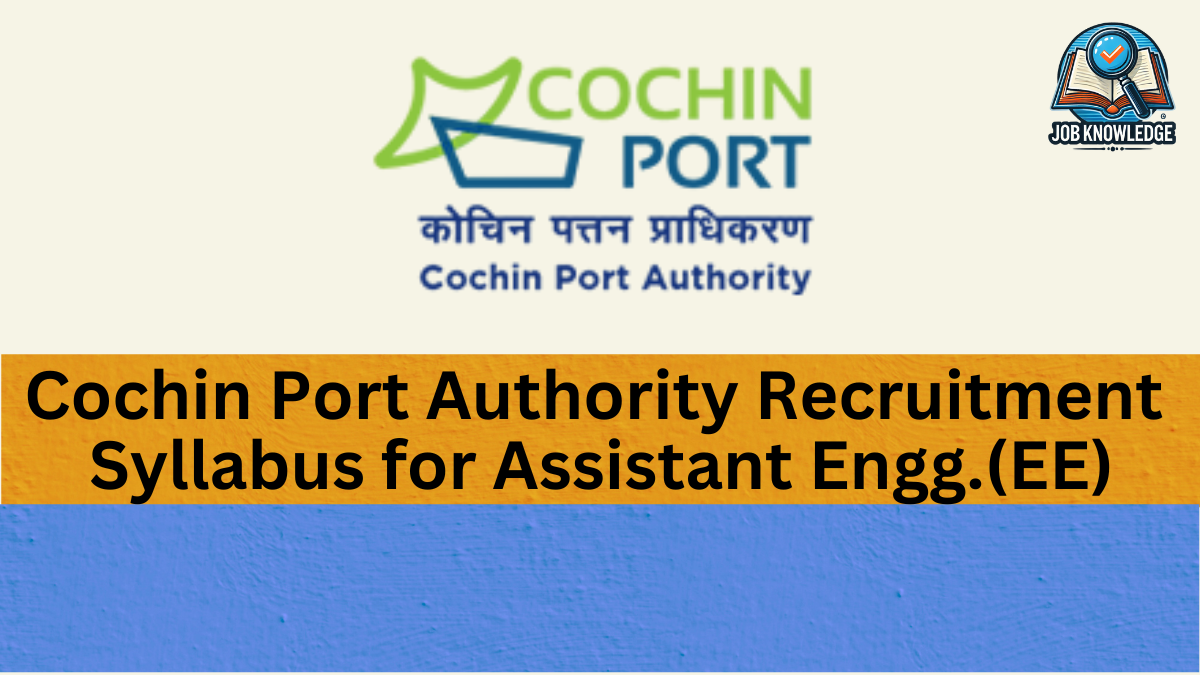| Cochin Port Authority Recruitment Syllabus:- Cochin Port Authority, under Advertisement No. A9/DR/Cl.I&II/2024-S dated 23.01.2025, has issued an important exam notice dated 04.06.2025 for the post of Assistant Engineer (Electrical) – Class II. The written examination is scheduled for 13th July 2025 and will be held in Ernakulam District. The exam will be conducted in both objective and descriptive format with a comprehensive syllabus covering all major Electrical Engineering topics. Candidates can download their Hall Tickets from the official portal about one week before the exam. |
Cochin Port Authority Recruitment Details
| Parameter | Details |
|---|---|
| Recruiting Authority | Cochin Port Authority |
| Advertisement No. | A9/DR/Cl.I&II/2024-S |
| Post Name | Assistant Engineer (Electrical) – Class II |
| Job Location | Ernakulam District, Kerala |
| Exam Date | 13th July 2025 |
| Hall Ticket Availability | One week before the exam via https://career.itiltd.in/careers_cochin_port/ |
| Exam Duration | 3 Hours |
| Exam Type | Part A: Descriptive (30 Marks) Part B: Objective (70 Marks) |
| Negative Marking | 0.25 marks for each wrong answer in Objective section |
| Exam Center | Ernakulam District, Kerala |
| Official Website | www.cochinport.gov.in |
| Helpline Email | secretary@cochinport.gov.in |
Syllabus for Cochin Port AE (Electrical) 2025 Exam
| Subject Area | Topics Covered |
|---|---|
| Electric Circuits | KCL, KVL, mesh and nodal analysis, resonance, transient response, Thevenin & Norton theorem, power factor, 3-phase circuits, two-port networks |
| EM Fields | Coulomb’s law, electric field intensity, Gauss’s law, Biot-Savart, Ampere’s law, Lorentz force, magnetic circuits, inductance |
| Signals & Systems | Fourier, Laplace, z-Transform, sampling theorem, continuous/discrete signals |
| Electrical Machines | Transformers, DC machines, 3-phase induction motors, synchronous machines, efficiency calculations |
| Power Systems | AC/DC transmission, per-unit systems, load flow (GS, NR methods), fault analysis, circuit breakers, protection schemes |
| Control Systems | Transfer functions, Routh, Nyquist, Bode plots, PID controllers, stability analysis, state-space models |
| Measurements | Voltage/current/power measurement, instrument transformers, digital meters, error analysis, oscilloscopes |
| Analog & Digital Electronics | BJT, MOSFET, op-amps, filters, logic circuits, A/D & D/A conversion, microprocessor 8085 |
| Power Electronics | SCR, Triac, IGBT; converters, inverters, PWM techniques, harmonics |
| Communication Techniques | Analog/digital modulation, signal characteristics, network protocols |
| General Aptitude & English | Reasoning, numerical ability, grammar, general knowledge |
Exam Pattern – Assistant Engineer (Electrical)
| Section | Type | No. of Questions | Marks | Marking Scheme |
|---|---|---|---|---|
| PART A | Descriptive | 7+2+2 = 11 Questions | 30 | Conceptual (2M), Analytical (3M), Problem-solving (5M) |
| PART B | Objective MCQ | 70 Questions | 70 | +1 per correct answer, -0.25 per wrong |
| TOTAL | 100 | Time: 3 hours |
Follow us on facebook for exclusive updates
Important Links
| Syllabus Notification | Click here |
| Official Website | Click here |
Follow us on Twitter for exclusive updates
FAQs (Frequently Asked Questions)
1. When is the Cochin Port AE (Electrical) exam scheduled?
The exam will be held on 13th July 2025 in Ernakulam District, Kerala.
2. How can I download the hall ticket for the exam?
You can download your hall ticket from the portal https://career.itiltd.in/careers_cochin_port using your User ID and Password one week before the exam.
3. Is there any negative marking in the Cochin Port AE exam?
Yes, there is a negative marking of 0.25 marks for every wrong answer in the objective section.
4. What is the total number of marks and duration of the exam?
The exam carries 100 marks (30 Descriptive + 70 Objective) and the duration is 3 hours.
5. What topics should I focus on for the descriptive part of the AE (Electrical) exam?
Focus on core Electrical concepts, problem-solving, and analytical reasoning as per the syllabus. Emphasis is given to transformers, machines, power systems, and control systems.

